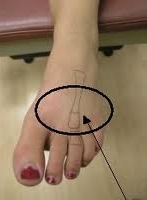In each feet, five bone bone fragments run from your posture to your toe combined parts. The first bone is smaller and wider than the other four bone fragments, which are usually identical in size. During the push-off stage when you move, leap or run, your bodyweight is moved to your feet and metatarsals. The first and second bone bone fragments take the impact of this power.
Most bone issues create when something changes in the way your feet normally works (mechanics), impacting how your bodyweight is allocated. This can put unwanted pressure on the metatarsals, resulting in swelling and pain, especially in the bone leads — the curved finishes of the bone fragments that link with your toe bone fragments.
Sometimes a single factor can cause to metatarsalgia. More often, several factors are involved, including:
Most bone issues create when something changes in the way your feet normally works (mechanics), impacting how your bodyweight is allocated. This can put unwanted pressure on the metatarsals, resulting in swelling and pain, especially in the bone leads — the curved finishes of the bone fragments that link with your toe bone fragments.
Sometimes a single factor can cause to metatarsalgia. More often, several factors are involved, including:
- Extreme training or action. Athletes are at chance of metatarsalgia, mainly because the top side of your feet takes up significant power when you run. But anyone who takes part in a high-impact game is also at threat, especially if your footwear are ill-fitting or are used out.
- Certain feet forms. A higher posture can put additional pressure on the metatarsals. So can having a second toe that's longer than the big toe, which causes more bodyweight than normal to be moved to the second bone head.
- Hammertoe. This feet issue can create when great heel footwear or too-small footwear avoid your feet from relaxing flat. Consequently, one of your feet — usually the second — waves downwards because of a fold in the center toe combined. This shrinkage depresses the bone leads.
- Bunion. This is a inflammed, agonizing force at the platform of your big toe. Sometimes the propensity to create hammer toes is got, but the issue can also outcome from dressed in great heel footwear or too-small footwear. Bunions are much more experienced by females too than in men. A bunion can damage your big toe, putting additional pressure on the football of your feet. Surgery to correct a bunion can also cause to metatarsalgia if you don't rest long enough for your feet to cure completely.
- Extra bodyweight. Because most of your bodyweight exchanges to your foot when you move, unwanted weight mean more pressure on your metatarsals. Reducing bodyweight may reduce or remove signs of metatarsalgia.
- Badly suitable footwear. High pumps, which exchange additional bodyweight to the top side of your feet, are a typical cause of metatarsalgia in females. Shoes with a filter toe box or footwear that lack support and cushioning also can promote bone issues.
- Stress bone injuries. Little smashes in the metatarsals or toe bone fragments can be agonizing and change the way you put bodyweight on your feet.
- Morton's neuroma. This noncancerous growth of " floating " fibrous cells around a sensors usually happens between the third and 4th bone leads. It causes signs that are just like metatarsalgia and can also promote bone pressure. Morton's neuroma frequently results from dressed in great heel footwear or too-tight footwear that put pressure on your feet. It can also create after high-impact actions such as running and aerobic exercise.







